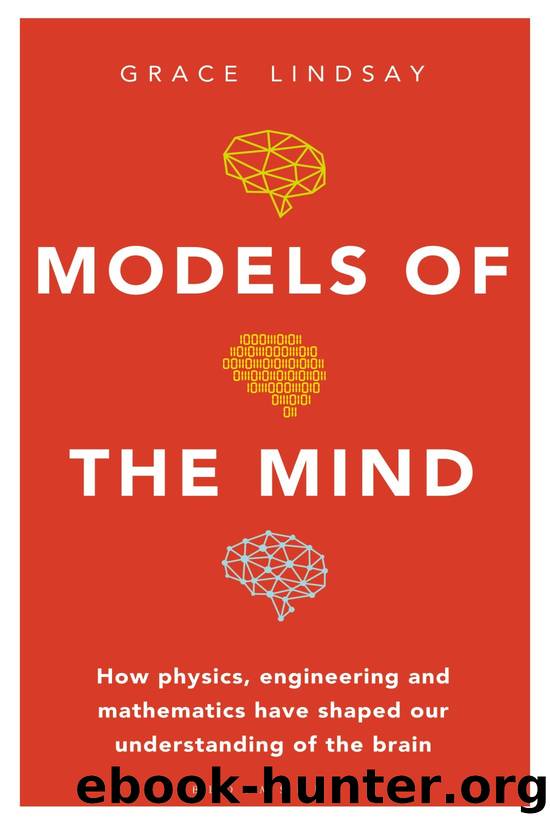Models of the Mind by Grace Lindsay

Author:Grace Lindsay
Language: eng
Format: epub
Publisher: Bloomsbury Publishing Plc
CHAPTER EIGHT
Movement in Low Dimensions
Kinetics, kinematics and dimensionality reduction
In the mid-1990s, a local newspaper editor in Houston, Texas, went to Baylor College of Medicine hoping to get help with a problem concerning his left hand. For the past several weeks, the fingers of this hand had been weak and the fingertips had gone numb. The man, a heavy smoker and drinker, appeared to the doctors to be in decent health otherwise. Seeing the numbness, the doctors initially searched for a pinched nerve in his wrist. Finding nothing there, they checked the spinal cord, suspecting that a lesion in the spinal nerves might be to blame. When evidence for that too came back negative, the doctors went one step further and performed a scan of the brain. What they found was a tumour â the size of a large grape â lodged into the right side of the wrinkled surface of the manâs brain. It was halfway between his right temple and the top of his head, in the middle of a region known as the motor cortex.
The motor cortex takes the shape of two thin strips starting at the top of the head and running down each side, together forming a headband across the top of the brain.1 Different parts of each strip control different parts of the opposite side of the body. In the case of the newspaper editor, his tumour was in the hand-controlling region of the right motor cortex. It also extended a bit into the sensory cortex â a similarly arranged strip right behind the motor cortex that controls sensation. This placement explained the weakness and numbness respectively â problems that subsided after the surgical removal of the tumour.
Since its discovery roughly 150 years ago, the motor cortex has found itself at the centre of many controversies. That the brain controls the body is undisputed; data from injuries indicated this fact as early as the pyramid age of ancient Egypt. But how it does so is another question.
In some ways, the connection between the motor cortex and movement is straightforward. Itâs a connection that follows a path opposite to the investigation taken by the Baylor doctors: neurons in the motor cortex on one side of the brain send outputs to neurons in the spinal cord on the other side, and these spinal cord neurons go directly to specific muscle fibres. The spot where the spinal cord neuron meets the muscle is called the neuromuscular junction. When this neuron fires, it releases the neurotransmitter acetylcholine into this junction. Muscle fibres respond to acetylcholine by contracting and movement occurs. Through this path, neurons in the cortex can directly control muscles.
But this is not the only road between the motor cortex and muscle. The other paths are more meandering. Some motor cortex neurons, for example, send their outputs to intermediate areas such as the brainstem, basal ganglia and cerebellum. From these areas the connections then go on to the spinal cord. Each such pit stop offers an opportunity for further processing of the signal, causing a change in the message that gets sent to the muscles.
Download
This site does not store any files on its server. We only index and link to content provided by other sites. Please contact the content providers to delete copyright contents if any and email us, we'll remove relevant links or contents immediately.
| Administration & Medicine Economics | Allied Health Professions |
| Basic Sciences | Dentistry |
| History | Medical Informatics |
| Medicine | Nursing |
| Pharmacology | Psychology |
| Research | Veterinary Medicine |
Periodization Training for Sports by Tudor Bompa(8217)
Why We Sleep: Unlocking the Power of Sleep and Dreams by Matthew Walker(6659)
Paper Towns by Green John(5142)
The Immortal Life of Henrietta Lacks by Rebecca Skloot(4552)
The Sports Rules Book by Human Kinetics(4348)
Dynamic Alignment Through Imagery by Eric Franklin(4180)
ACSM's Complete Guide to Fitness & Health by ACSM(4023)
Kaplan MCAT Organic Chemistry Review: Created for MCAT 2015 (Kaplan Test Prep) by Kaplan(3972)
Introduction to Kinesiology by Shirl J. Hoffman(3745)
Livewired by David Eagleman(3732)
The Death of the Heart by Elizabeth Bowen(3583)
The River of Consciousness by Oliver Sacks(3574)
Alchemy and Alchemists by C. J. S. Thompson(3484)
Bad Pharma by Ben Goldacre(3399)
Descartes' Error by Antonio Damasio(3250)
The Emperor of All Maladies: A Biography of Cancer by Siddhartha Mukherjee(3115)
The Gene: An Intimate History by Siddhartha Mukherjee(3076)
The Fate of Rome: Climate, Disease, and the End of an Empire (The Princeton History of the Ancient World) by Kyle Harper(3036)
Kaplan MCAT Behavioral Sciences Review: Created for MCAT 2015 (Kaplan Test Prep) by Kaplan(2961)
